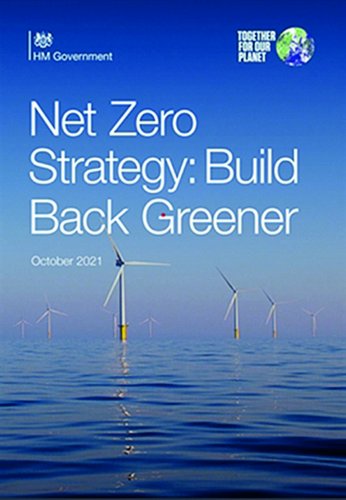Details of how the Government’s Net Zero Strategy with affect the coach and bus industry have been revealed
The UK Government has published its long-heralded Net Zero Strategy with just under two weeks to go before the COP26 climate summit begins in Glasgow. In sections focused on transport, the strategy promises: “We will transform our cities and towns with greener, faster and more efficient transport. Our streets will be cleaner and people healthier from breathing cleaner air, walking and cycling more”.
Entitled ‘Net Zero Strategy: Build Back Greener,’ the strategy confirms that, subject to further consultation, the Government intends to introduce a zero-emission vehicle (ZEV) mandate to ‘guarantee greater number of zero-emission vehicles on our roads, unlocking the transformation of our road transport.’
The strategy promises further funding of £350m from the Automotive Transformation Fund (ATF) to support the electrification of UK vehicles and their supply chains and £620m for zero-emission vehicle grants and EV infrastructure, including further funding for local EV Infrastructure, with a focus on local on-street residential charging.
Prime Minister Boris Johnson’s foreword to the strategy predicts: “In 2050, we will still be driving cars, flying planes and heating our homes, but our cars will be electric, gliding silently around our cities, our planes will be zero-emission allowing us to fly guilt-free.”
However, it also acknowledges the need for modal shift and more active travel to complement private car use, saying: “We will increase the share of journeys taken by public transport, cycling and walking, investing £3 billion to transform bus services and £2 billion for cycling. Accelerating the decarbonisation of transport will save lives and significantly reduce noise, making our urban centres more enjoyable places to live.”
- Other policy commitments in the strategy include commitments to:
- Take action to increase average road vehicle occupancy from 1.55 to 1.7, with work under way to build the evidence base ‘to understand the barriers and potential policies to increase the uptake of shared mobility’;
- Transform local transport systems, with 4,000 new zero-emission buses and the infrastructure to support them;
- Deliver the National Bus Strategy’s vision of a transformed bus industry and a green bus revolution;
- The UK’s first all-electric bus city to be delivered with £50 million to fund up to 300 electric buses and charging infrastructure;
- Take forward the pledge to end the sale of all new, non-zero-emission road vehicles by 2040, from motorcycles to buses and HGVs, subject to consultation. A consultation on an appropriate date to end the sale of new non-zero-emission buses and on the appropriate supporting policy and regulatory framework has already begun. The Government will also consult on a phase out date for the sale or purchase of new non-zero-emission coaches;
- Support decarbonisation by investing more than £12 billion in local transport systems over the current parliament;
- Consult this year on a phase-out date of 2035, or earlier if a faster transition appears feasible, for the sale of new non-zero-emission two and three wheelers and other L-category vehicles;
- Make quantifiable carbon reductions a fundamental part of local transport planning and funding, with Local Transport Plans (LTPs) to set out how local areas will deliver ambitious carbon reductions in line with carbon budgets and net zero;
- Embed transport decarbonisation principles in spatial planning and across transport policy making, and;
- Reduce the barriers to data sharing across the transport sector.
The Government has already committed to end the sale of new petrol and diesel cars and vans from 2030 and, from 2035, all new cars and vans must be zero-emission at the tailpipe. The proposed new zero-emission vehicle mandate will set targets, with the details subject to further consultation, for a percentage of manufacturers’ new car and van sales to be zero-emission each year from 2024.
There is also a commitment, starting later this year, to publish an EV infrastructure strategy, setting out the Government’s vision for infrastructure rollout, and the roles for the public and private sectors in achieving it.
Commenting on the Net Zero Strategy, Zemo Partnership’s CEO, Andy Eastlake said: “The Government recognises that transport is now the biggest sector for carbon emissions and is tackling this huge challenge on a wide range of fronts.
“The zero-emission mandate is a potentially powerful new lever in the policymakers’ armoury and will help to ensure that the phase-out dates for internal combustion-engined vehicles are met, or exceeded. I’m particularly pleased to see mentions of the potential for smaller, L-category, vehicles to contribute to this agenda as well as the commitment to continue to focus on decarbonising fuels for as long as they remain a significant part of our transport energy mix – two areas of activity that Zemo Partnership has consistently championed. As is clearly stated in the detail of the document, technology will have to be complemented by behaviour changes in all aspects of mobility if we’re to achieve the net zero target. This is almost certainly the most challenging but, undoubtedly, the most exciting time ever to be working in transport.”
A spokesperson for the Confederation of Passenger Transport (CPT) said: “The Net Zero Strategy rightly recognises the importance of more journeys being made by bus and coach instead of by car, but we must not underestimate the scale of this challenge and targets for this switch are noticeably absent from the strategy. The Committee on Climate Change says that we need to see one in 10 car journeys made today made by bus by 2030 to reach net zero. This requires action now to begin to change peoples’ behaviour. Buses can be made a more attractive option given greater priority in road space allocation via the ongoing Bus Service Improvement Plan process and sufficient funding at next week’s Spending Review to match the ambition to put buses at the heart of transport networks.”


